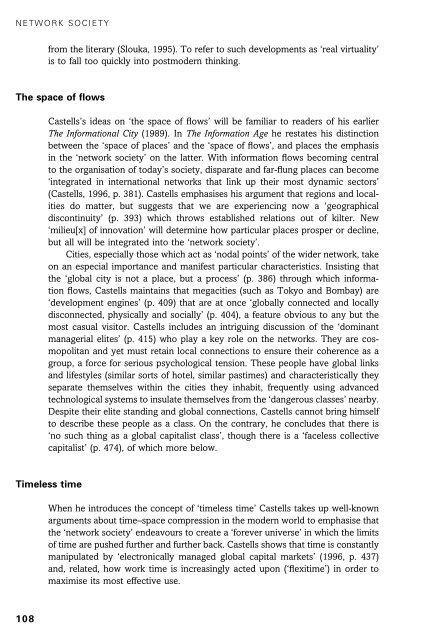Theories of the Information Society, Third Edition - Cryptome
Theories of the Information Society, Third Edition - Cryptome
Theories of the Information Society, Third Edition - Cryptome
You also want an ePaper? Increase the reach of your titles
YUMPU automatically turns print PDFs into web optimized ePapers that Google loves.
NETWORK SOCIETY<br />
from <strong>the</strong> literary (Slouka, 1995). To refer to such developments as ‘real virtuality’<br />
is to fall too quickly into postmodern thinking.<br />
The space <strong>of</strong> flows<br />
Castells’s ideas on ‘<strong>the</strong> space <strong>of</strong> flows’ will be familiar to readers <strong>of</strong> his earlier<br />
The <strong>Information</strong>al City (1989). In The <strong>Information</strong> Age he restates his distinction<br />
between <strong>the</strong> ‘space <strong>of</strong> places’ and <strong>the</strong> ‘space <strong>of</strong> flows’, and places <strong>the</strong> emphasis<br />
in <strong>the</strong> ‘network society’ on <strong>the</strong> latter. With information flows becoming central<br />
to <strong>the</strong> organisation <strong>of</strong> today’s society, disparate and far-flung places can become<br />
‘integrated in international networks that link up <strong>the</strong>ir most dynamic sectors’<br />
(Castells, 1996, p. 381). Castells emphasises his argument that regions and localities<br />
do matter, but suggests that we are experiencing now a ‘geographical<br />
discontinuity’ (p. 393) which throws established relations out <strong>of</strong> kilter. New<br />
‘milieu[x] <strong>of</strong> innovation’ will determine how particular places prosper or decline,<br />
but all will be integrated into <strong>the</strong> ‘network society’.<br />
Cities, especially those which act as ‘nodal points’ <strong>of</strong> <strong>the</strong> wider network, take<br />
on an especial importance and manifest particular characteristics. Insisting that<br />
<strong>the</strong> ‘global city is not a place, but a process’ (p. 386) through which information<br />
flows, Castells maintains that megacities (such as Tokyo and Bombay) are<br />
‘development engines’ (p. 409) that are at once ‘globally connected and locally<br />
disconnected, physically and socially’ (p. 404), a feature obvious to any but <strong>the</strong><br />
most casual visitor. Castells includes an intriguing discussion <strong>of</strong> <strong>the</strong> ‘dominant<br />
managerial elites’ (p. 415) who play a key role on <strong>the</strong> networks. They are cosmopolitan<br />
and yet must retain local connections to ensure <strong>the</strong>ir coherence as a<br />
group, a force for serious psychological tension. These people have global links<br />
and lifestyles (similar sorts <strong>of</strong> hotel, similar pastimes) and characteristically <strong>the</strong>y<br />
separate <strong>the</strong>mselves within <strong>the</strong> cities <strong>the</strong>y inhabit, frequently using advanced<br />
technological systems to insulate <strong>the</strong>mselves from <strong>the</strong> ‘dangerous classes’ nearby.<br />
Despite <strong>the</strong>ir elite standing and global connections, Castells cannot bring himself<br />
to describe <strong>the</strong>se people as a class. On <strong>the</strong> contrary, he concludes that <strong>the</strong>re is<br />
‘no such thing as a global capitalist class’, though <strong>the</strong>re is a ‘faceless collective<br />
capitalist’ (p. 474), <strong>of</strong> which more below.<br />
Timeless time<br />
When he introduces <strong>the</strong> concept <strong>of</strong> ‘timeless time’ Castells takes up well-known<br />
arguments about time–space compression in <strong>the</strong> modern world to emphasise that<br />
<strong>the</strong> ‘network society’ endeavours to create a ‘forever universe’ in which <strong>the</strong> limits<br />
<strong>of</strong> time are pushed fur<strong>the</strong>r and fur<strong>the</strong>r back. Castells shows that time is constantly<br />
manipulated by ‘electronically managed global capital markets’ (1996, p. 437)<br />
and, related, how work time is increasingly acted upon (‘flexitime’) in order to<br />
maximise its most effective use.<br />
108
















